ShodhKosh: Journal of Visual and Performing ArtsISSN (Online): 2582-7472
|
|
AN OVERVIEW OF TRADITIONAL
KANCHIPURAM SILK SAREES
Nellutla Keerthi 1![]()
![]() ,
Mokanaa Sri E 2
,
Mokanaa Sri E 2![]()
![]()
1 Bachelor
of Design, Department of Fashion Design, School of Arts and Design, Woxsen University, Hyderabad, Telangana -502345, India
2 Research
Scholar, Department of Fashion Design, School of Arts and Design, Woxsen University, Hyderabad, Telangana -502345, India
|
|
ABSTRACT |
||
|
Kanchipuram
Silk Sarees are among the most desired traditional wear for the
ever-bothersome question of elegance and prestige of culture, as well as for
the legendary history of this district and the brilliantly exclusive
craftsmanship combining this textile. South Indian bridal culture has existed
for ages, and the Kanchipuram silk saree has been a ruling trend among more
sophisticated ladies for a long time. The charming silk sarees, designed
individually with gold or silver zari and pure silk
threads, from Kanchipuram, a town in Tamil Nadu, are examples of the textile
industry's brilliant creations. Kanchipuram Silk Sarees are a paragon of
taste and history for their intricate craftsmanship that depicts their
exclusive weaving styles, choice of luxury materials, and everlasting
patterns. These sarees convey the rich textile legacy of our country and mesmerise worldwide fashion enthusiasts with their
extraordinary combination of culture and modernity. They are still worn as a
form of importance during events and passed down as family heirlooms because
they are truly outstanding pieces. This paper covered the historical value,
manufacturing methods, current trends, market identification, and cultural
importance of Kanchipuram silk sarees in contemporary times. It also
thoroughly describes the features and their still-thriving cognizance today
in eastern Indian fabrics. In addition, the SWOT analysis included in this
study highlights the strengths, weaknesses, opportunities, and threats
associated with the Kanchipuram silk industry. Elements of the fabric,
including durability and brilliance, as well as intricate patterns and
motifs, are the main selling points for maintaining its rich cultural legacy. |
|||
|
Received 29 June 2023 Accepted 08 June 2024 Published 13 June 2024 Corresponding Author Mokanaa Sri E, mokanaadevreddy.98@gmail.com DOI 10.29121/shodhkosh.v4.i2CDSDAD.2023.1083 Funding: This research
received no specific grant from any funding agency in the public, commercial,
or not-for-profit sectors. Copyright: © 2023 The
Author(s). This work is licensed under a Creative Commons
Attribution 4.0 International License. With the
license CC-BY, authors retain the copyright, allowing anyone to download,
reuse, re-print, modify, distribute, and/or copy their contribution. The work
must be properly attributed to its author.
|
|||
|
Keywords: Kanchipuram Silk, South Indian Textiles, Weaving
Heritage, Cultural Significance, Traditional Craftsmanship, Intricate Motifs |
|||
1. INTRODUCTION
The relevance of Kanchipuram silk sarees in Indian fashion and culture, especially in the colourful tapestry of South India, With their rich silk and gold threads, these handcrafted sarees from Kanchipuram, Tamil Nadu, epitomise grandeur and tradition. They are a must-have for bridal wear and momentous occasions. These sarees, which the Indian government has designated as a Geographical Indication, represent the area's rich history and exquisite artistry. Exquisitely woven from locally produced Zari and pure mulberry silk, their designs are influenced by the rich patterns seen in mythological stories, the grandeur of nature, and temple architecture. Kanchipuram silk sarees are an enduring representation of classic South Indian aesthetics, with their characteristic broad contrast borders, temple borders, checks, stripes, and floral motifs Arvind (2021b).
Hindu mythology tells us that the master weavers behind these stunning works were the famed Sage Markanda, whose descendants are the source of the Kanchipuram saree's tradition. Every Kanchipuram saree tells a tale of elegance and heritage with vivid colours, detailed zari embroidery with silver threads dipped in gold, and exquisite motifs. These sarees, which are frequently worn at weddings and other formal occasions in South Indian culture, are treasured as sacred representations of purity and grace and are revered as emblems of wealth and refinement. Admirers are always drawn to Kanchipuram silk sarees because of their exceptional craftsmanship and timeless appeal. Touted by A-listers in various fields, they have crossed international borders to catch the eye of major fashion industry players like Chanel and Louis Vuitton. Their longevity, exquisite craftsmanship, and deep cultural importance all contribute to their ongoing appeal and guarantee their place in Indian fashion and culture Gowri (2018).
This paper aims to comprehensively understand the cultural and historical significance of Kanchipuram silk sarees, their current market trends, and their economic impact. It also proposes potential strategies for sustaining and promoting Kanchipuram silk in the global market. The commercial success of these sarees is a testament to their enduring appeal and the global recognition of their quality and craftsmanship.
Figure 1

|
Figure 1 Kanchipuram Sarees Source Artisan |
2. METHODOLOGY
This paper is obtained from secondary sources such as academic papers, blogs, magazines, industry reports, and credible online articles, which contain relevant information regarding the historical background, cultural importance, marketing, trends, quality, craftsmanship, weaving techniques, designs, and motifs of woven silk. It also focused on the socio-economic aspects of Kanchipuram silk.
3. REFLECTION
OF TRADITION AND CULTURAL LEGACY
Kanjivaram sarees, often made of silk and found in Kanchipuram, have a rich history that dates back to the Pallava dynasty, which ruled from the 5th to the 9th centuries CE. Kanchipuram, known as the "Silk City," is renowned for its handwoven silk sarees, symbolizing luxury and tradition. As a hub for trade, culture, and the arts, Kanchipuram flourished throughout this time. The weaving industry in Kanchipuram owes its development to the patronage of the Pallava kings, who laid the groundwork for the sector's future expansion. The Chola dynasty, which came to power after the Pallavas, further enhanced silk weaving at Kanchipuram. The silk industry in the region was greatly aided by the Chola monarchs, who were also exceptional patrons of the arts. Kanchipuram's weavers thus developed highly skilled techniques and started crafting gorgeous silk sarees that were in great demand. During the Vijayanagara Empire, which ruled from the 14th to the 17th centuries CE, Kanchipuram silk weaving achieved its pinnacle. Because of the empire's encouragement and backing, the weavers were able to hone their skills and create silk sarees that were unmatched in beauty and craftsmanship. Kanchipuram's textile heritage was further enhanced by the Vijayanagara dynasty, which even encouraged talented weavers from nearby areas to relocate there. Kanchipuram silk sarees have seen significant advancements over the years. The silk weaving tradition of Kanchipuram began under the Chola dynasty, and it flourished especially under King Krishnadevaraya's tenure. Kanchipuram's creative and technical diversity in weaving was enhanced by the migration of Andhra Pradesh weaving communities like the Saligars and Devangas Menon (2023).
Hindu mythological motifs give rise to the cultural and theological significance of Kanchipuram silk sarees in southern India, particularly in Tamil Nadu, Kerala, Karnataka, and Andhra Pradesh. As a reflection of their ingrained cultural legacy, these sarees are frequently worn at weddings, festivals, and other special occasions. The Kanchipuram silk saree industry has recently adapted to changing consumer tastes and technical improvements. Techniques like computer-aided design have been incorporated to create intricate designs and motifs that appeal to contemporary tastes. Despite these developments, the industry has continued to uphold authenticity and quality standards. Genuine Kanchipuram silk sarees are still valued for their super craftsmanship and classic beauty because government and business associations have banded together to fight counterfeit goods Rajan (2019).
The excellent craftsmanship, classic beauty, and international acclaim of Kanchipuram silk sarees are well known. These sarees, which are made of exquisite silk, stand out for their vivid hues, elaborate patterns, and elegant use of zari threads, which are frequently weaved with silver or gold to give them an opulent appearance. Kanchipuram silk sarees, handed down through the years, are highly prized as reminders of cultural history and ties to the family. Due to their vivid colours and timeless appeal, they are frequently used in special events worldwide. These sarees, which combine avant-garde patterns with their classic elegance, have evolved to suit modern preferences while still paying homage to South Indian traditions. They must be properly cared for to keep their beauty, as they are frequently worn as bridal gowns. Kanchipuram silk sarees are a beloved wardrobe staple and a testament to Indian artistry. They have received international recognition for preserving cultural heritage. Often called Kanjivaram silk sarees, they are a tribute to the generations of talented artisans they honor and represent the pinnacle of elegance and grace Mishra & Mishra (2021).
Kanchipuram silk sarees are exquisite and textured and
made from natural mulberry silk strands. The weeks invested in their
construction demonstrate the weavers' unwavering dedication and proficiency.
These sarees' elaborate motifs and decorations, which draw inspiration from
temple art and nature, complement the pallu's unique zigzag Korvai
pattern. Celebrities love to wear Kanchipuram silk sarees for festivals,
weddings, and other special occasions because of their classic elegance and
opulent appeal. Depending on the design's complexity and quality, prices range
from Rs. 3,000 to Rs. 4,000,000. The longevity and charm of Kanchipuram silk
sarees must be preserved and maintained properly. Dry cleaning preserves the
cloth's luster and quality, guaranteeing its
attractiveness lasts for many years. Furthermore, frequent airing aids in
preventing colour fading Samyakkadmin. (2024a).
Figure 2

|
Figure 2 Kanchipuram Sarees Source https://mavuris.com/products/parrot-green-kanchipuram-silk-saree-3
|
Figure 3

|
Figure 3 Kanchipuram Tissue Silk Sarees Source https://www.kankatala.com/kanchipuram-silk-tissue-jaal-violet-saree-1212486914.html |
4. WEAVING TECHNIQUES AND MATERIALS
Like the old textiles, the Kanchipuram silks will keep their traditional weave and material technique, which is still crafted with skillful and experienced hands. The method combines pure mulberry silk thread with fine embroidery on the zari, which is formed into myriad designs using gold and silver. Warp threads are thrown on pit looms using methods like adai for the border and petni for palla in the same manner the sarees are being woven. Weavers in Kanchi adopt the ancient technique of Korvai to create baselines and pallus, which are integrated into the fabric and give it strength. A saree is made from two-ply silk yarn. Every thread is one of the three plaited single threads twisting together, giving the saree its qualities and traits M V & Viji (2022b). The weavers' skill, coupled with inter-generational transfer, puts on the traditional touch of Kanchipuram silk weaving, highlighting the kind of premium they put on the process that takes a long time and a high degree of expertise. In some cultures, the flow of weaving is
4.1. Raw Silk
The process is initiated with the best silk from the mulberry, which originates from South India, more precisely, Bangalore. From the silkworms feeding on fresh silkworms, raw silk is produced, which is then used for weaving.
4.2. Twisting
In Kanchipuram, the artisans weave the raw silk into the warp and weft threads using their unique expertise and skill. In this phase, the actual number of threads per square inch and the number of sarees that will be produced will be decided.
4.3. Motifs and Development
Common motifs in Kanchipuram silk include peacocks,
parrots, mangoes, lotus flowers, and geometric patterns. Mythological themes
from the Ramayana and Mahabharata are also frequently incorporated. Master
weavers and clients review initial designs. Once the design is approved, it is
transferred onto punch cards. In the past, these designs were created on graph
paper, but nowadays, technological advancements have enabled the use of digital
designs created with CAD (Computer-Aided design).
Figure 4
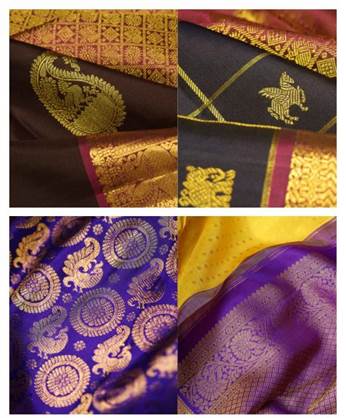
|
Figure 4
Traditional
Motifs and Patterns |
4.4. Dyeing
The warp and weft threads undergo hand-dying to achieve the desired colours. This critical phase involves manual cleaning, degumming, and uniformly mixing the colour powders into water.
4.5. Warping
The silk saree becomes an art of different threads that have been thoroughly put into the loom. The total width depends on the threads used. The woven borders of Zari, like the silk warp threads, imitate the shape of the loom.
4.6. Weaving
The loom operator hands the light shuttle to the weaver for use in the final process, which involves skipping the shuttle across the spaces or gaps between the warp threads. A typical Kanjivaram silk saree fabrication needs approximately 7,000 single shuttle movements before the saree can be completed.
4.7. Folding
After the saree is pulled from the loom, it is folded with precision by considering the pre-marked folder lines. Such lines remain until the saree is ironed. Being lightweight ensures a simple re-folding of the saree afterward Ramsamy (2022).
Figure 5

|
Figure 5 Handmade Motifs on Graph Sheets Source Artisan |
Figure 6

|
Figure 6 CAD
Design Source
Artisan |
Figure 7
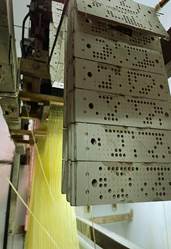
|
Figure 7 Punch
Card Source
Artisan |
Figure 8
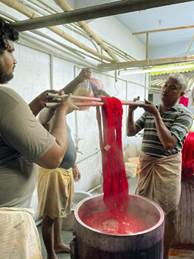
|
Figure 8 Yarn
Dyeing Source
Artisan |
Figure 9

|
Figure 9 Preparing
Warp Source
Artisan |
Figure 10
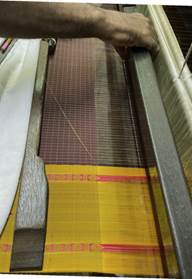
|
Figure 10 Weaving
Process Source
Artisan |
5. EVOLUTION OF
TRADITIONAL MOTIFS IN CONTEMPORARY DESIGN
The distinctive designs of traditional patterns and motifs, as seen in Indian textiles, are influenced by regional factors like the environment, philosophy, religion, and social and cultural values. These motifs have great historical significance in addition to being creative examples. To convey significant concepts and accurately represent local customs, values, and objectives, symbolic themes are necessary. Paintings from the Mughal era still feature the Hansa motif, which has mystical connotations and dates back to the Indus Valley Civilization. It is also present in Ajanta cave wall art. Similarly, the Cintamani insignia, symbolizing the Buddhist trinity, has become globally recognized and has crossed cultural barriers. Alongside societal shifts and technological developments, these themes and patterns have changed. Traditional designs changed due to the British colonial era's introduction of modern machinery and synthetic dyes. Hybrid patterns were also created via the cross-national interchange of motifs via international trade networks. The inventiveness and tenacity of artisanal communities throughout history are generally embodied in traditional patterns and motifs, which enhance humankind's cultural legacy and inspire contemporary culture Prabhakar (2023b).
Kanchipuram silk sarees epitomize South Indian weaving skills while appealing to a broad spectrum of consumers through a seamless marriage of traditional artistry and contemporary design. Kanchipuram silk sarees are valued for their classic beauty, cultural significance, and connotation of luxury, and the fashion world acknowledges their enduring appeal despite shifting trends. In South Indian culture, sarees are still a sign of elegance and riches, and celebrities, politicians, and business executives worldwide value them. Preserving Kanchipuram silk sarees' traditional artistry is crucial to the industry's success going forward. Programs that support fair trade principles and sustainable materials can also provide training for aspiring weavers. The fact that Kanchipuram silk sarees are featured in high-profile events and worldwide fashion collections shows that these efforts have contributed to their visibility outside of South India Gupta (2021a).
Figure 11
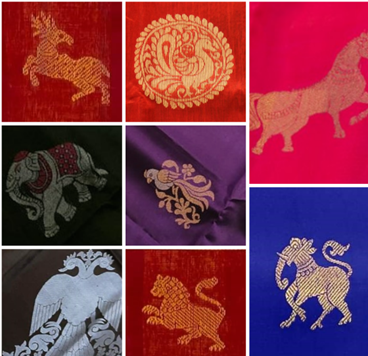
|
Figure 11 Contempary Motifs Source https://inyaboutique.com/blogs/blog/motifs-on-kanchipuram-sarees |
Kanchipuram silk sarees, also called Kanjivaram
sarees, have a rich cultural and religious past steeped in South Indian
tradition. They are treasured as representations of beauty, grace, and elegance
and are frequently worn during formal events and traditional rituals. Every
saree is a unique piece of art, meticulously crafted from premium silk threads
and adorned with zari embroidery that lends an air of
grandeur. Despite their labor-intensive production
process, Kanchipuram silk sarees are known for their durability, vivid colours,
and elaborate designs. They are cherished for their rich history and
magnificence, handed down through the years as heirlooms. Their fascination is
not limited to South India; it has captured the hearts of celebrities and
fashionistas everywhere, exhibiting its timeless beauty and cultural relevance
on a global scale Fernandes (2023).
6. GLOBAL RECOGNITION AND FUTURE PROSPECTS SWOT ANALYSIS
Asia produces more than 95% of the world's silk, making it the leading producer worldwide. China, India, Japan, Brazil, and Korea are the top five silk-producing nations out of over forty. As the world's largest supplier of silk, China stands out in particular with its 1.5 lakh MT yearly production. The artful weaver Sage Markanda is credited with creating the first Kanchipuram silk sarees. He crafted garments for the gods, including a tissue made of lotus petals. His heirs, who are today known as Kanchi Silk Weavers, inherited his skill in weaving Manoranjan (n.d.-a).
In the Indian village of Kanchipuram, silk sarees are woven by hand, and it is credited to these weavers that they created the famous designs. As the "temple city" or the "city of a thousand temples," Kanchipuram gained notoriety 400 years ago when two well-known weaving clans, the Saligars, and the Devangas, moved there from a nearby state and brought their extraordinary silk weaving talents with them. In South India, Kanchipuram silk sarees hold great value, mainly due to their opulent status during wedding ceremonies. These sarees attract costs ranging from Rs. 2500 to Rs. 1,00,000, depending on the complexity of the work involved. They are highly prized for their unusual colour combinations, exquisite designs, and outstanding craftsmanship Londhe (2015).
Globally recognized for their stunning designs, superior materials, and unique weaving techniques, Kanjivaram sarees are a fashion statement. Selected as Geographically Indicated (GI), this esteemed designation exclusively applies to sarees manufactured in Kanchipuram and its surrounding areas. They are highly respected by women from many cultures, especially South Asia and the Middle East. Growing consumer interest in sustainability and various patterns presents chances for Kanchipuram's silk makers to develop and meet changing market demands. More artistic freedom has been encouraged without sacrificing quality requirements, thanks to recent regulatory relaxations regulating the use of gold-silver mixtures in these sarees. Designers use modern aspects like digital printing techniques, abstract patterns, and contemporary hues to appeal to younger generations while keeping classic aesthetics Sivasakthi (2018).
The global market for Kanchipuram silk sarees remains dominant despite obstacles, including competition from synthetic materials and counterfeit goods. The sector's expansion is being driven by the rising demand for goods with cultural significance and the expanding acceptance of natural fibers. Kanchipuram silk sarees have a bright future thanks to initiatives to preserve fair trade norms and safeguard intellectual property rights. The Kanchipuram silk saree business has a bright future ahead of it, allowing it to overcome challenges and welcome continuity, innovation, and variety. Kanchipuram's standing as a "Silk Paradise of the South," luring travelers from all across the country, highlights the pure silk sarees' relevance on a global scale Kiron et al. (2020).
7. CURRENT TRENDS AND MARKETING
Kanchipuram sarees are today more popular than ever, with unique patterns, eye-catching colour combinations, and beautiful embroidery, thanks to their remarkable quality, durability, and traditional charm. The sector is predicted to prosper through innovation, adaptation, and authenticity preservation despite obstacles, including growing input costs and diminishing sales. They are blending Kanchipuram silk with others like cotton and kora or incorporating non-traditional elements to create unique, hybrid sarees that cater to diverse tastes and occasions. Creating weightless, light shades and simple motifs of traditional Kanchipuram silk sarees for ease of wear makes them suitable for formal and casual settings. Mishra & Mishra (2021).
The exquisite craftsmanship and classic styles of Kanchipuram silk sarees are well known, and they help to create a distinguished brand image steeped in history and culture. Those who appreciate history and authenticity are drawn to these sarees. Sustaining market dominance is difficult in the face of intense rivalry from domestic and foreign competitors. Refinement of pricing, merchandising, and product range strategies is necessary to be competitive in a market that is changing quickly Menon (2023).
Using contemporary technologies can improve audience engagement. For example, establishing an integrated ICT platform for marketing and sales can unlock new business opportunities. There will be plenty of growth opportunities when new marketing techniques are introduced, and unexplored domestic and international markets are reached. Partnering with renowned fashion designers and luxury brands to create exclusive Kanchipuram silk saree collections, showcasing Kanchipuram silk sarees at national and international fashion events, and utilizing e-commerce platforms and social media to reach a broader audience. The fierce rivalry between multiple Indian and foreign vendors threatens the well-established reputation of Kanchipuram silk sarees. The ongoing need for traditional goods like Kanchipuram silk sarees is challenged by outside variables, including shifting consumer preferences and market dynamics. The Kanchipuram silk saree business players can strategically arrange themselves by utilizing their strengths, correcting their weaknesses, seizing chances, and reducing dangers. A SWOT analysis can offer invaluable insights when navigating the competitive landscape shaped by cutting-edge technology Sivasakthi (2018).
7.1. SWOT Analysis
7.1.1. Strengths
Kanchipuram silk sarees have a centuries-old tradition behind the craft passed down through generations; hence, they have high cultural significance. The sarees are best known for their durability, intricate designs, and high-quality materials, so they are considered a premium product. The Brand Kanchipuram silk is not only famous in India but has gained wide recognition in the world market Fernandes (2023).
7.1.2. Weaknesses
The exclusive application of pure silk and gold/silver zari powder makes these sarees expensive, leading to less targeting of a broader market Londhe (2015). The skilled hand-weaving process is complex and lengthy; thus, production volumes are affected. Industries face shortages of manual skilled workers, especially weavers, whose numbers are diminishing because of the youth's declining interest in this sector. There is also a shortage of modern technologies and design machinery.
7.1.3. Opportunities
A large opportunity involves expansion into foreign markets via tailored marketing campaigns and e-commerce platforms. Keeping modern designs and fashion trends up-to-date could attract younger buyers. Highlighting ecological production and the potential of sustainable methods is one way of finding consumers sensitive to environmental needs. Younger generations of consumers have become more fans of Indian heritage crafts Sivasakthi (2018).
7.1.4. Threats
The market provides lavish options of machine-made imitations selling at a lower price, which disrupts the wholesale of genuine Kanchipuram silk. Shifts in silk and gold costs and an economic recession can have a negative impact on weaving. The change in consumers' behaviour towards cheap and trendy fabrics. Low support for and policy for the handloom sector Sivasakthi (2018).
8. CONCLUSION
Kanchipuram silk is an example of ancient artisanal mastery. From materials like high-quality banarasi to complicated weaving techniques like korvai and petni,sarees are created after a careful process. The incorporation of vibrant colours in these sarees also highlights their cultural significance through traditional motifs like temple borders and floral designs. Despite the obstacles of the modern era, including the application of sustainable practices and the utilization of innovation, the Kanchipuram silk industry still adds to the local economy and protects an invaluable cultural heritage.
This paper concluded through secondary data that the intricate knowledge emphasizes the conservation of traditional methods and the assimilation of technological advancements to preserve this unique craft. The Kanchipuram silk saree revolution brought forth many collaborations between Indian weavers and international fashion designers, whereby they honored art and culture. Nowadays, silk sarees from Kanchipuram, which impress all those who wear them, are distinctive in their way, as they are an outstanding combination of tradition, workmanship, elegance, and cultural heritage.
CONFLICT OF INTERESTS
None.
ACKNOWLEDGMENTS
None.
REFERENCES
Arvind, U. (2021b, March 8). History and the Making of a Kanjivaram Silk Saree. Thamboori Silks.
Fernandes, C. (2023, July 7). Kanchipuram Silk Sarees: Drapes of South Indian Royalty. Maradi.
Gowri, P. (2018, December). An Over View on the Growth of Kanchipuram Silk Industry - ISBR.
Gupta, M. (2021a, February 25). Historic Design Motifs, the History, Culture and Anthropology. Marasim.
Kiron, M. I., & Mazharul Islam KironFounder & Editor of Textile Learner. He is a Textile Consultant. (2020, December 17). Present Scenario of Kanchipuram Silk Saree Industry. Textile Learner.
Londhe, C. U. (2015, December). Competitiveness of Silk and Hand Loom Paithani.
M V, N. K., & Viji. (2022b, December 9). Vikaspedia Domains. Vikaspedia.
Manoranjan, M. S. (n.d.-a). Internship Report on KSIC PDF. Scribd.
Menon, A. (2023, March 22). Kanchipuram Silk Sarees: The Timeless Elegance of South India. Enroute Indian History.
Mishra, P., & Mishra, A. P. (2021, September 27). Trendy & Distinctive Ways to Style Kanjeevaram Sarees. ShaadiWish.
Prabhakar, M. (2023b, October 22). The Elegance Unveiled: Factors that Define Pure Kanchipuram Silk Saree. Mavuris.
Ramsamy, K. (2022, December 27). The Making of a Hand-Woven Kanjivaram Silk Saree. Shreenivas Silks.
Samyakkadmin. (2024a, February 15). Exploring the Elegance of Kanjivaram Silk Sarees: A Timeless Tradition - Samyakk: Sarees: Sherwani: Salwar Suits: Kurti: Lehenga: Gowns: Mens Wear. Samyakk.
Sivasakthi, R. (2018, April). A Knowledge Torch on Consumer Preferences.
|
|
 This work is licensed under a: Creative Commons Attribution 4.0 International License
This work is licensed under a: Creative Commons Attribution 4.0 International License
© ShodhKosh 2023. All Rights Reserved.

